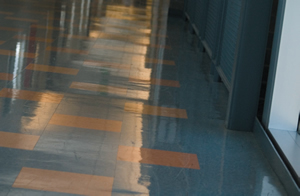At this time of year,wet floors are a constant challenge . Staff and visitors often arrive with wet feet,wet coats and even dripping umbrellas and bags. With so many entrances and reception areas laid with hard-wearing, hard floor surfaces, this can quickly cause real problems and the risk of slipping escalates dramatically. Richard Harrison considers some solutions
At this time of year,wet floors are a constant challenge. Staff and visitors often arrive with wet feet,wet coats and even dripping umbrellas and bags. With so many entrances and reception areas laid with hard-wearing, hard floor surfaces, this can quickly cause real problems and the risk of slipping escalates dramatically. Richard Harrison considers some solutions
The first preconception that must be challenged is the myth that shiny floors are all slippery. With the latest sealants and flooring protection treatments, this need not be the case. Indeed, there are many products on the market that can protect the floor at the same time as providing a slip-resistant surface, suitable to meet the requirements of the Pendulum test specified by BS7976.
Relevant legislation
Under the Health and Safety at Work etc Act 1974, employers have to ensure their employees and anyone else who could be affected by their work (such as visitors), are kept safe from harm and that their health is not affected. This means that risks must be controlled to ensure that people do not slip, trip and fall. The Management of Health and Safety at Work Regulations 1999 build on the requirements of the Act and include duties on employers to assess risks (including slip and trip risks) and, where necessary, take action to safeguard health and safety. The Workplace (Health, Safety and Welfare) Regulations 1992 require floors to be suitable for the workplace and work activity, kept in good condition and kept free from obstructions.
Scale of the risk
The HSE publishes figures that summarise the total cost of slips, trips and falls to be over £800 million per year, with the financial impact on the National Health Service totalling £133 million and the expense for employers at £500 million. The nature of the costs are listed, from loss of income for the individual sustaining the accident, to fines and loss of image for the organisation responsible.
This type of injury results in over eight times as many hospital bed days as car accidents and, with an increasingly litigious society, has long term financial implications.
When slips and trips occur due to flooring, it is invariably due to damage or deterioration of the surface, the presence of spills, or walked-in debris, such as wet leaves. All these factors can be easily addressed with straightforward floor care.
A practical approach
Having set the scale of the risk and the scope of the cost in context, the next consideration for most is what practical measures can be taken to mitigate it. The first step has to be an assessment of the current flooring surfaces and consideration of their anti-slip properties.
Renovation may be required and this can be as simple as a re-polish on stone or a screen on wood, followed by a reseal. Application of a new slip-resistant sealant will not only address the slip risk, but also prolong the lifetime of the flooring and the minimal cost involved can be justified either in H&S or facilities' terms. The return on investment of the flooring asset will convince the financial controller, even if the financial implication of the H&S risk doesn't.
Attention needs to be focused where highest traffic will be seen and greatest slip risk is present. This will be in the walkways that visitors choose and peak around entrances and exits - where rain, dirt and debris enters the building. Here the crucial action should be to provide adequate, good quality barrier matting.
Often under-provisioned, barrier matting should capture the first six footfalls of any visitor entering the space. In harsher weather conditions, installed matting can quickly become saturated (both in terms of liquid and particulates) so should be supplemented with loose matting that can be swapped out and cleaned. Inadequate barrier matting can exacerbate the slip risk, if allowed to become saturated. Once full, the mat can act like an ink pad, with each footstep picking up dirt and liquid to carry forward onto the floor.
Once flooring has been appropriately treated and barrier matting deployed to act as front line defence, then it is essential to maintain the standard achieved. This requires a proactive approach to flooring maintenance - over and above appropriate cleaning. Putting a regular programme of care in place which upholds the anti-slip integrity of the surface, will extend the useful life of the floor and ensure that it performs well - aesthetically, functionally and safely.
Richard Harrison works for flooring experts
PHS Interclean


